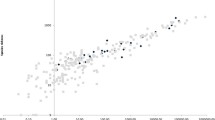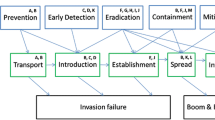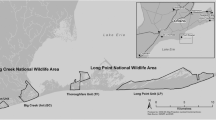Abstract
Since 1958, L. microphyllum (Old World Climbing Fern), which originated from the Old World Tropics, has become a nuisance exotic and has rapidly spread and is being established system-wide in extremely remote and undisturbed areas such as the Florida Everglades. Of particular concern is that L. microphyllum is disrupting, at an alarming rate, the flora and fauna of the native ecosystem at the same time that a major 8.4 billion dollar Everglades restoration program is trying to enhance these same attributes. This research utilized IKONOS satellite data to map L. microphyllum within the 58,000-ha Loxahatchee National Wildlife Refuge wetland in south Florida. Results show that approximately 11.6% of the tree/shrub vegetation within the impoundment has been infected by L. microphyllum. These data were then utilized to explore the spatial spread patterns of L. microphyllum within the Refuge. Results suggest that L. microphyllum is more likely to establish on the southeast side of a tree/shrub island and then spread to the northwest, which corresponds to the prevailing wind direction in south Florida. Spatial pattern analysis of L. microphyllum spread indicated that it is correlated with the density and spatial distribution of tree/shrub island vegetation. It appears that the dispersion of L. microphyllum is density dependent, which can be expressed as a logistic function and has a catastrophic threshold of 160 m of mean distance between tree/shrub islands in the Everglades. It is predicted that 38% (or 1910 ha) of tree/shrub islands in the Refuge will be invaded by L. microphyllum by 2012. Tree islands in the Everglades wetland could be considered similar to oceanic islands throughout the world that are notoriously vulnerable to biological invasions.
Similar content being viewed by others
References
JW Beardsley (1979) ArticleTitleNew immigrant insects in Hawaii: 1962 through 1976 Proceedings of the Hawaiian Entomological Society 23 35–44
LA Brandt DW Black (2001) ArticleTitleImpacts of the introduced fern, Lygodium microphyllum, on the native vegetation of Tree Islands in the Arthur R. Marshall Loxahatchee National wildlife Refuge Florida Scientist 64 IssueID3 191–196
Chen C and Gerber JF (1990) Climate. In: Myers RL and Ewel JJ (eds) Ecosystems of South Florida, pp 11–34. University of Central Florida Press, Orlando, Florida
PJ Clark FC Evans (1954) ArticleTitleDistance to nearest neighbor as a measure of spatial relationships in populations Ecology 35 445–453 Occurrence Handle10.2307/1931034
Darby C and McKercher LR (2002) Bones wrapped in Lygodium microphyllum rachis suggest a potential problem for wildlife. Wildland Weeds. Fall, vol. 5, No. 4, 14 pp
M Duryea T Caraco G Gardner W Maniatty BK Szymanski (1999) ArticleTitlePopulation dispersion and equilibrium infection␣frequency in a spatial epidemic Physica D 132 511–519 Occurrence Handle10.1016/S0167-2789(99)00059-7
HH Edie (1978) Ferns of Hong Kong Hong Kong University Press Hong Kong
Everitt BS, Landau S and Leese M (2001) Cluster Analysis, 4th edn. Edward Arnold, London
Florida Exotic Pest Plant Council (FEPPC) (2001) Lygodium Management Plan for Florida. Amy Ferriter (ed) South Florida Water Management District, West Palm Beach, Florida, USA, 51 pp
DE Gawlik P Gronemeyer RA Powell (2002) Habitat-use patterns of avian seed dispersers in the central everglades FH Sklar A Valk Particlevan der (Eds) Tree Islands of the Everglades Kluwer Academic Publishers Dordrecht, The Netherlands 445–468
DE Gawlik DA Rocque (1998) ArticleTitleAvian communities in bayheads, willowheads, and sawgrass marshes of the central Everglades Wilson Bulletin 110 IssueID1 45–55
Gardner RH and O’Neil RV (1991) Pattern, process, and predictability: the use of neutral models for landscape analysis. In: Turner M and Gardner RH (eds) Quantitative Methods in Landscape Ecology, pp 289–308. Springer- Verlag, New York
M Hasebe PG Wolf KM Pryer K Ueda M Ito R Sano GJ Gastony J Vokoyama JR Manhart N Murahami EH Crane CH Huafler WD Hauk (1995) ArticleTitleFern Phylogeny based on rbcl nucleotide sequences American Fern Journal 85 134–181 Occurrence Handle10.2307/1547807
SJ Holbrook RJ Schmitt (2003) ArticleTitleSpatial and temporal variation in mortality of newly settled damselfish: patterns, causes, and co-variation with settlement rates Oecologia 135 532–541 Occurrence Handle16228252
M Ichael BE Isen P Aul TS Pellman P Atrick OB Rown D Avid B Otstein (1998) ArticleTitleCluster analysis and display of genome-wide expression patterns Proceedings of the National Academy of Sciences of the United States of America 95 14,863–14,868
PV Kirch (1997) Introduction: the environmental history of oceanic islands PV Kirch TL Hunt (Eds) Historical Ecology in the Pacific Islands: Prehistoric Environmental and Landscape Change Yale University Press New Haven, Connecticut, USA 1–21
Langeland KA (2003) Natural area weeds: old world climbing fern (Lygodium microphyllum). http://edis.ifas.ufl.edu/BODY_AG122
LL Loope D Mueller-Dombois (1989) Characteristics of invaded islands HA Mooney (Eds) et al. Ecology of Biological Invasions: A Global Synthesis John Wiley & Sons Chichester, England 257–280
CM Loveless (1959) ArticleTitleA study of the vegetation in the Florida Everglades Ecology 40 1–9 Occurrence Handle10.2307/1929916
Marquet PA, Fortin M, Pineda J, Wallin DO, Clark J, Wu Y, Bollens S, Jacobi CM and Holt RD (1993) Ecological and evolutional consequences of patchiness: a marine- terrestrial perspective. In: Levin SA, Powell TM and Steele JH (eds) Ptachy Dynamics, pp 277–304. Springer-Verlag, Berlin
KM Nagata (1985) ArticleTitleEarly plant introductions in Hawaii Hawaiian Journal of History 19 35–61
Nauman CE (1993) Lygodium C. Presl. In: Flora of North America Editorial Committee (eds) Flora of North America, Vol. 2, Pteridophytes and Gymnosperms, Oxford University Press, New York
CE Nauman DF Austin (1978) ArticleTitleSpread of the exotic fern Lygodium microphyllum in Florida American Fern Journal 68 65–66 Occurrence Handle10.2307/1546450
Richardson JR, Bryant WL, Kitchens WM, Mattson JE and Pope KR (1990) An Evaluation of Refuge Habitats and Relationships to Water Quality, Quantity, and Hydroperiod. A Synthesis Report to Arthur R. Marshall Loxahatchee National Wildlife Refuge, Boynton Beach, Florida, USA, 145 pp
D Roberts (1997) ArticleTitle L. microphyllum research and mitigation at Jonathan Dickinson State Park Florida Department of Environmental Protection Resource Management Notes 9 IssueID2 30–32 Occurrence Handle1:STN:280:ByiB3Mzjs1Y%3D
Roberts RE (1996) The monster of hobe sound. In: Bodle M (ed) Proceedings of Invasive Vines Workshop. South Florida Water Management District, West Palm Beach, FL, 35 pp
RW Russell GL Hunt SuffixJr KO Coyle RT Cooney (1992) ArticleTitleForaging in a fractal environment: spatial patterns in marine predator–prey system Landscape Ecology 7 IssueID3 195–209 Occurrence Handle10.1007/BF00133310
N Shigesada K Kawasaki (1997) Biological Invasion: Theory and Practice Oxford University Press New York
S Singh G Panigrahi (1984) ArticleTitleSystematics of the genus Lygodium Sw. (Lygodiaceae) in India Proceedings of the Indian Academy Science (Plant Science) 93 IssueID2 119–133
Sklar FH, Coronado-Molina C, Gras A, Rutchey K, Gawlik D, Crozier G, Bauman L, Hagerthy S, Shuford R, Leeds J, Wu Y, Madden C, Garrett B, Nungesser M, Korvela M and McVoy C (2004) Chapter 6: ecological effects of hydrology. In 2004 Everglades Consolidated Report, South Florida Water Management District, West Palm Beach, FL, 58 pp
Sklar FH and van der Valk A (eds) (2002) Tree Islands of the Everglades. Kluwer Academic Publishers, Dordrecht, The Netherlands, 541 pp
AR Smith (1995) ArticleTitleNon molecular phylogenetic hypothesis for ferns American Fern Journal 85 104–122 Occurrence Handle10.2307/1547805
A Suarez DA Holway TJ Case (2001) ArticleTitlePatterns of spread in biological invasions dominated by long-distance jump dispersal: insights from Argentine ants PNAS 98 IssueID3 1095–1100 Occurrence Handle11158600 Occurrence Handle1:CAS:528:DC%2BD3MXht1Smsbs%3D Occurrence Handle10.1073/pnas.98.3.1095
D Tilman (1988) Plant Strategies and the Dynamics and Structure of Plant Communities Princeton University Press Princeton, New Jersey 360
Turner M and Gardner RH (eds) (1991) Quantitative Methods in Landscape Ecology. Springer-Verlag, New York, 535 pp
JC Volin MS Lott JD Muss D Owen (2004) ArticleTitlePredicting rapid invasion of the Florida Everglades by Old World Climbing Fern (Lygodium microphyllum) Diversity and Distribution 10 439–446 Occurrence Handle10.1111/j.1366-9516.2004.00091.x
Wu Y, Rutchey K, Guan W, Vilchek L and Sklar FH (2002) Spatial Simulations of Tree Islands for Everglades Restoration. In: Sklar FH and van der Valk A (eds) Tree Islands of the Everglades, pp 469–499. Kluwer Academic Publishers, Dordrecht, The Netherlands
Y Wu FH Sklar K Rutchey (1997) ArticleTitleAnalysis and simulations of fragmentation patterns in the Everglades Ecological Applications 7 IssueID1 268–276 Occurrence Handle10.2307/2269423
RP Wunderlin (1998) Guide to the Vascular Plants of Florida University Press of Florida Gainsville, Florida, USA
Author information
Authors and Affiliations
Corresponding author
Rights and permissions
About this article
Cite this article
Wu, Y., Rutchey, K., Wang, N. et al. The spatial pattern and dispersion of Lygodium microphyllum in the Everglades wetland ecosystem. Biol Invasions 8, 1483–1493 (2006). https://doi.org/10.1007/s10530-005-5840-3
Issue Date:
DOI: https://doi.org/10.1007/s10530-005-5840-3




